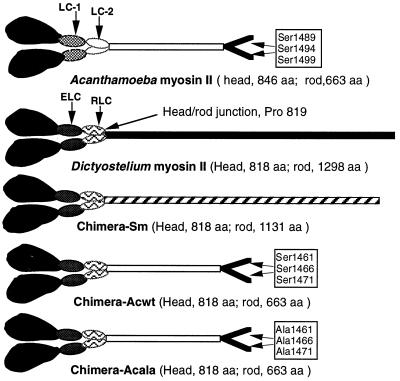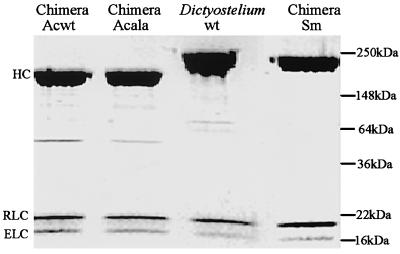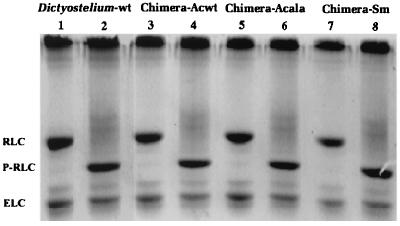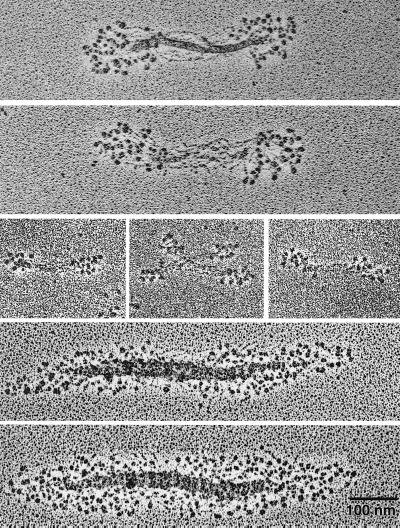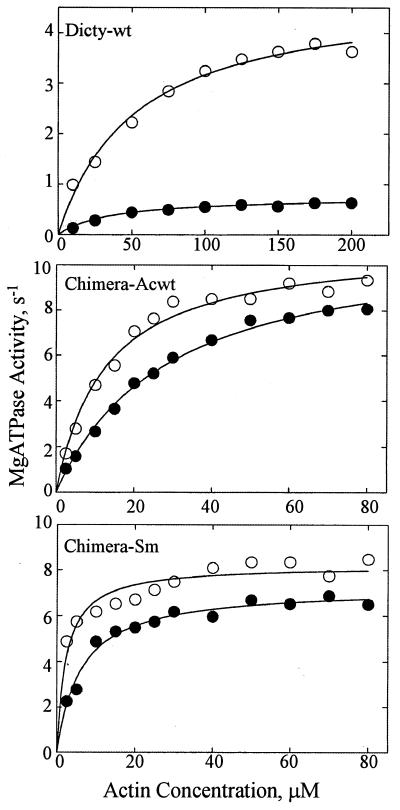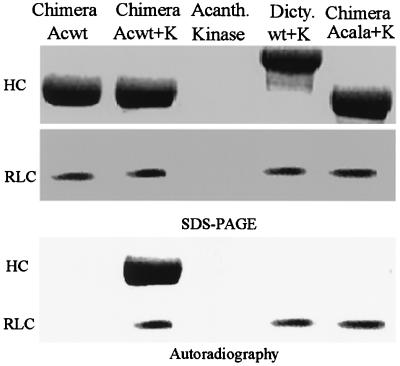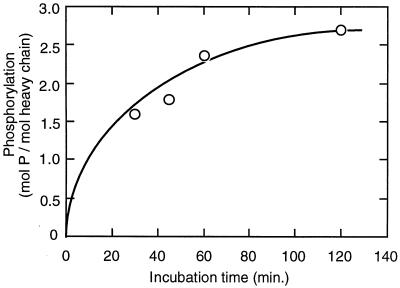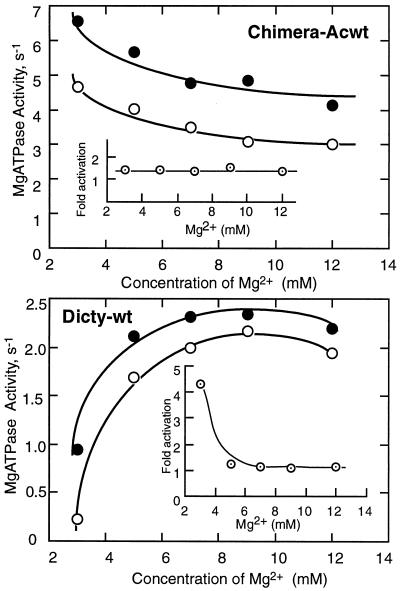Abstract
Phosphorylation of the regulatory light chain of Dictyostelium myosin II increases Vmax of its actin-dependent MgATPase activity about 5-fold under normal assay conditions. Under these assay conditions, unphosphorylated chimeric myosins in which the tail domain of the Dictyostelium myosin II heavy chain is replaced by either the tail domain of chicken gizzard smooth muscle or Acanthamoeba myosin II are 20 times more active because of a 10- to 15-fold increase in Vmax and a 2- to 7-fold decrease in apparent KATPase and are only slightly activated by regulatory light chain phosphorylation. Actin-dependent MgATPase activity of the Dictyostelium/Acanthamoeba chimera is not affected by phosphorylation of serine residues in the tail whose phosphorylation completely inactivates wild-type Acanthamoeba myosin II. These results indicate that the actin-dependent MgATPase activity of these myosins involves specific, tightly coupled, interactions between head and tail domains.
Myosins are a superfamily of actin-based motors that convert the energy derived from actin-dependent hydrolysis of ATP into force. Class II myosins, one of as many as 18 different myosin classes (1, 2), contain two heavy chains and two pairs of light chains (1). Each heavy chain has an N-terminal globular head followed by a helical neck and a C-terminal tail. The head domain contains the actin-binding and catalytic sites, each neck domain binds two light chains, and the tail domains of two heavy chains form a single α-helical, coiled-coil rod through which myosin II molecules self-assemble into filaments (1).
The actin-dependent MgATPase activity of Dictyostelium myosin II (3) and many smooth muscle and nonmuscle class II myosins (1) is regulated by phosphorylation of the regulatory light chain (RLC), i.e., inhibition by unphosphorylated RLC is derepressed by phosphorylation. In the case of Dictyostelium myosin II, unphosphorylated RLC inhibits activity only when the myosin is filamentous (4) and specific (probably intramolecular) interactions between residues in the tail and head and/or neck domains are involved (5). On the other hand, filaments are not required for regulation of smooth muscle myosin II but two heads are. For example, soluble heavy meromyosin is regulated but soluble subfragment 1 and single-headed filaments are not (6–10). The specific amino acid sequence of the coiled-coil helix that holds the two chains together may not be important (9), although there is some evidence to the contrary (10), as long as it exceeds a certain minimum required length (10).
Acanthamoeba myosin II, although structurally similar to other class II myosins, is not regulated by light chain phosphorylation. Instead, its actin-dependent MgATPase activity is almost completely inhibited by phosphorylation of three serine residues in the C-terminal, nonhelical tail-piece of each heavy chain (11, 12). Although extensively investigated (11–16), the structural basis of this inhibition is still not clear. It is known, however, that only filamentous Acanthamoeba myosin II is regulated, that regulation is intermolecular, and that inhibition of actin-dependent MgATPase activity is closely correlated with an increase in flexibility of the hinge region that interrupts the coiled-coil helix at about 40% of the distance between the phosphorylation sites and the neck/tail junction.
The purpose of the experiments reported in this paper was to determine whether the communications between the heavy chain head and tail domains that are essential for the regulation of Dictyostelium and Acanthamoeba myosin II depend on specific sequences or conformations that are unique to each myosin or on properties that are shared with other class II myosins. To answer this question, we expressed heavy chain chimeras with the head and neck domains of Dictyostelium myosin II fused to the tail domain of smooth muscle or Acanthamoeba myosin II in Dictyostelium myosin II heavy chain-null cells. We then asked whether the actin-dependent MgATPase activity of the Dictyostelium myosin II head, with associated Dictyostelium myosin II light chains, was regulated by RLC phosphorylation in both chimeric myosins, and by heavy chain phosphorylation in the chimera that contained the Acanthamoeba tail.
Materials and Methods
Construction of Chimeric Myosins.
Standard methods were used for all DNA manipulations (17). The fragment spanning BglII and KpnI in pMyDAP (18) was subcloned into Litmus 28 (New England Biolabs), resulting in LMyD(K/B). An MluI site and a stop codon were introduced downstream of KpnI in LMyD(K/B) by PCR using pMyDAP (18) as template to make LMyD (K/B Mlu). The sense primer, 5′-GGTGTTTTAGAAAAGACTCGTGTCAGATTAC-3′, contained a PshAI site (underlined) and the antisense primer, 5′-CAACATTGACGGTACCAGATACGCGTTACAATG-3′, contained a KpnI site (first underlined region), an MluI site (second underlined region), and a stop codon (bold). An EcoRV fusion site was created near the neck/tail junction of the Dictyostelium myosin sequence in LMyD (K/B Mlu) by PCR via silent mutation using pMyDAP (18) as the template, resulting in pMyD(K/B M/E). The sense primer, 5-TCATGGCCATGGTGGAAACTCTTCTCAAAGGCTCGTCCACTGATATCCAGAAGAAAC-3′, contained an NcoI site (first underlined region) and an EcoRV site (second underlined region); the antisense primer, 5′-CCAATTCACTTTGTAATCTGACACGAGTCATTTCTAAAACAC-3′, contained a PshAI site (underlined).
The DNA coding for the full-length tail of Acanthamoeba myosin II was constructed by PCR using pGEX-KT carrying the entire tail of Acanthamoeba myosin II (19) as the template. The sense primer, 5′-CGACAAGGCCCGCCCGCTGATATCCCACGTAAC-3′, created an EcoRV site (underlined) via silent mutation. The antisense primer, 5′-GAGGGAGGCACGACGCGTTATTCCTCG-3′, introduced an MluI site (underlined) immediately downstream of the stop codon of the Acanthamoeba myosin II gene (bold). The PCR product was subcloned at MluI and EcoRV sites of LMyD(K/B M/E), resulting in LMyD(Acwt). A sense primer, 5′-CGCAACGAGCTCGACGTCACCGCC-3′, containing an AatII site (underlined) and the antisense primer used for construction of the LMyD(Acwt) described above were used to generate chimera-Acala DNA using as template pGEX-KT carrying a mutant tail of Acanthamoeba myosin II in which the three phosphorylatable serines were mutated to three alanines. The PCR products were subcloned into LMyD(Acwt) to replace the sequence between MluI and AatII sites, resulting in LMyD(Acala). The PCR products in LMyD(Acwt) and LMyD(Acala) were verified by sequencing. LMyD(Acwt) and LMyD(Acala) were subcloned into pBigMyDT-4 (20) by MluI and BglII digestion, resulting in pBigChimera-Acwt and pBigChimera-Acala.
Details of the construction of the DNA coding for chimera-Sm heavy chain, consisting of the head and neck of Dictyostelium myosin II and the tail of chicken gizzard smooth muscle myosin II, and its subcloning into pTIKL vector (5) to make pTIKLChimera-Sm will be published later (S.S., T. Q. P. Uyeda, and E.D.K., unpublished work).
The pBig-chimeras carrying each substitution mutation, pTIKLChimera-Sm and pTIKLMyD (5), were introduced by electroporation (22) into Dictyostelium cells that lack an endogenous copy of mhcA (21), and transformants were selected by growth in the presence of 12 μg/ml G418 in HL5 medium containing 60 μg/ml each of penicillin and streptomycin.
Culture of Dictyostelium Cells.
All transformants were maintained on plates containing HL5 medium with 60 μg/ml each of penicillin and streptomycin and 12 μg/ml G418 at 22°C. For large-scale cultures, Dictyostelium myosin II heavy chain-null cells expressing the myosin chimeras and wild-type Dictyostelium myosin II were grown in the same medium but without G418 in a 4-liter flask on a rotary shaker at 170 rpm at 22°C.
Preparation of Proteins.
All procedures were carried out at 4°C. Wild-type Dictyostelium myosin II was purified as described (5) and chimeric myosins by a slightly modified procedure. Briefly, the NaCl concentration of the wash buffer was 200 mM instead of 150 mM and 0.1 mM PMSF and protease inhibitor mixture (Boehringer Mannheim) were included only in the lysis buffer. For polymerization of chimera-Acwt and chimera-Acala, the dialysis buffer was 20 mM imidazole, pH 7.0, containing 15 mM MgCl2, 20 mM KCl, and 1 mM DTT. The dialysis buffer for polymerization of chimera-Sm was 10 mM imidazole, pH 7.0, containing 20 mM NaCl, 0.1 mM EGTA, and 1 mM DTT. After dialysis, 1 M MgCl2 was added to a final concentration of 20 mM. Myosins were stored in liquid nitrogen until use.
Acanthamoeba myosin heavy chain kinase (MHCK) was partially purified as described (23). Rabbit skeletal muscle actin was prepared according to the method of Spudich and Watt (24). Bacterially expressed Dictyostelium myosin light chain kinase (MLCK), carrying an activating T166E mutation (25), was purified by affinity chromatography on Ni-NTA resin (25). Purified kinase was dialyzed against 10 mM Hepes, pH 7.5, containing 1 mM DTT and kept in liquid nitrogen until use. MLCK was electrophoretically homogeneous as determined by SDS/PAGE.
Determination of Protein Concentrations.
Actin concentrations were determined spectrophotometrically by using an extinction coefficient of 0.62 cm2/mg at 290 nm. Myosin concentrations were determined by the method of Bradford (26) with chicken gizzard smooth muscle myosin as standard. The concentration of the smooth muscle myosin standard was determined spectrophotometrically by using an extinction coefficient of 0.52 cm2/mg at 280 nm.
Phosphorylation of Myosins.
Myosins were phosphorylated by Dictyostelium MLCK according to Ruppel et al. (22) and by partially purified Acanthamoeba MHCK as described (23).
ATPase Assays.
Steady-state ATPase activities were determined at 30°C by measuring 32Pi released from [32P]ATP (27). The standard reaction mixtures for the assay of MgATPase activity contained 20 mM imidazole (pH 7.5), 0.1 mM CaCl2, the indicated concentration of MgCl2, 2 mM [32P]ATP, and 50 μg/ml myosin, with or without 23 μM F-actin. The reaction mixture for measuring the high-salt CaATPase activity was 0.6 M KCl, 5 mM CaCl2, 3 mM [32P]ATP, and 10 mM imidazole, pH 7.5. Reactions were started by the addition of myosin that had been dialyzed against low-salt buffer.
Electrophoresis.
SDS/PAGE was carried out according to Laemmli (28) with a separating gel consisting of two layers: 7.5% acrylamide and 13% acrylamide in 5% glycerol. Urea-SDS-glycerol PAGE was performed according to the modified method of Perrie and Perry (29) as described (22).
In Vitro Motility Assay.
The modified protocol of Sellers et al. (30) was used at 30°C in buffer containing 3 mM MgCl2 and 2 mM ATP. The RLC was phosphorylated while the myosin was bound to the slide by adding Dictyostelium MLCK in kinase buffer and incubating for 10 min.
Electron Microscopy.
Filaments were prepared by overnight dialysis against 20 mM imidazole, pH 7.5, containing 10 mM KCl, 3 mM MgCl2 and 0.1 mM CaCl2, suspended in the same buffer at 0.1 mg/ml, diluted with two parts of glycerol, sprayed onto freshly cleaved mica, and rotary-shadowed with platinum at an angle of 7° in a Balzer's 311 freeze-fracture unit at room temperature. Micrographs were taken in a JEOL 1200 EX II electron microscope at an accelerating voltage of 80 kV.
Results
Expression, Purification, and Structure of Chimeras.
The chimeric myosins (see Fig. 1) were expressed in Dictyostelium myosin II heavy chain-null cells about 60–70% as well as wild-type Dictyostelium myosin II (data not shown). All samples were highly purified with no detectable degradation of the heavy chain (Fig. 2) or light chains (Fig. 2 and see Fig. 4); chimera-Acwt and chimera-Acala were slightly contaminated by actin (Fig. 2).
Figure 1.
Schematic representation of the structures of the heavy chains of Acanthamoeba, Dictyostelium, and chimeric myosins. The 1,298-residue tail, beginning at Pro-819, of wild-type Dictyostelium myosin II heavy chain was replaced by the 1,131-residue and 663-residue tails of chicken gizzard smooth muscle and Acanthamoeba myosin II in chimera-Sm and chimera-Acwt heavy chains, respectively. The three serines whose phosphorylation inactivates the actin-dependent MgATPase of Acanthamoeba myosin II, and which were replaced by alanines in chimera-Acala, are numbered differently in the chimeras and wild-type heavy chains because the head/neck domain of Dictyostelium myosin II is 28 residues shorter than the head/neck domain of Acanthamoeba myosin II.
Figure 2.
SDS/PAGE analysis of purified wild-type Dictyostelium and chimeric myosins. The positions of the heavy chains (HC), regulatory (RLC), and essential (ELC) light chains are indicated.
Figure 4.
Urea/SDS/glycerol PAGE analysis of phosphorylation of RLC of wild-type Dictyostelium and chimeric myosins by Dictyostelium myosin II light chain kinase. Wild-type and chimeric myosins were incubated with MgATP with (lanes 2, 4, 6, 8) or without (lanes 1, 3, 5, 7) MLCK as described in Materials and Methods. The gel was stained with Coomassie blue. The positions of unphosphorylated (RLC) and phosphorylated (P-RLC) regulatory light chains and essential light chain (ELC) are indicated.
By electron microscopy, filaments of the chimeric myosins resembled filaments of the parental myosin that was the source of the tail and clearly differed from filaments of wild-type Dictyostelium myosin II, which, when prepared under conditions used for actin-dependent MgATPase assays, were 450-nm long bipolar filaments with a 150-nm central bare zone (Fig. 3). Chimera-Acwt filaments (Fig. 3), prepared under the same conditions, were uniformly bipolar with a length of about 200 nm and a clearly defined central bare zone of about 90 nm, as described for filaments of Acanthamoeba myosin II (31), and chimera-Sm filaments (Fig. 3) closely resembled side polar chicken gizzard myosin filaments (32) with a length of about 700 nm and no central bare zone.
Figure 3.
Rotary-shadowed electron microscopic images of filaments of wild-type Dictyostelium myosin II (two upper rows), chimera-Acwt (middle row), and chimera-Sm (two bottom rows). See Materials and Methods for details. The magnification is the same for all images; bar is 100 nm.
Effect of RLC Phosphorylation on ATPase Activities of Chimeras.
None of the purified myosins contained detectable phosphorylated RLC (Fig. 4) and, in all cases, the RLC was completely phosphorylated when the myosins were incubated with Dictyostelium MLCK (Fig. 4). The expressed wild-type Dictyostelium myosin and three chimeric myosins had indistinguishable high-salt CaATPase activities, 4.5–5 s-1, that were unaffected by light chain or heavy chain phosphorylation (data not shown); basal MgATPase activities, both before and after RLC phosphorylation, were also the same for wild-type, chimera-Acwt, chimera-Acala, and chimera-Sm (Table 1). Thus, the chimeric tails did not affect the fundamental catalytic properties of the ATPase site in the Dictyostelium myosin II head.
Table 1.
ATPase activities of wild-type Dictyostelium and chimeric myosins
| Myosin | MgATPase
|
|||||||||
|---|---|---|---|---|---|---|---|---|---|---|
| −Kinase
|
+MLCK*
|
+MHCK†
|
||||||||
| Basal | +Actin‡ | Vmax§ | KATPase§ | Basal | +Actin | Vmax | KATPase | Basal | +Actin | |
| Dicty wild type | 0.06 | 0.23 ± 0.03 | 0.76 | 41 | 0.11 | 1.22 ± 0.42 | 4.82 | 52.2 | 0.09 | 1.28 ± 0.12 |
| Chimera-Acwt | 0.08 | 4.85 ± 0.24 | 11.4 | 29.3 | 0.12 | 6.93 ± 0.02 | 10.78 | 12.67 | 0.16 | 6.53 ± 0.41 |
| Chimera-Acala | 0.09 | 5.43 | 0.12 | 7.70 | 0.20 | 7.46 | ||||
| Chimera-Sm | 0.07 | 5.21 | 7.25 | 6.08 | 0.12 | 6.24 | 8.2 | 2.3 | ||
Dictyostelium myosin II light chain kinase.
Acanthamoeba myosin II heavy chain kinase.
MgATPase activities were measured in 20 mM imidazole (pH 7.5), 3 mM MgCl2, 0.2 mM CaCl2, 1 mM DTT, and 2 mM ATP with and without 23 μM actin.
Calculated by fitting all the data in Fig. 5.
In agreement with others (4, 5, 22, 33, 34), RLC phosphorylation enhanced the actin-dependent MgATPase activity of wild-type Dictyostelium myosin about 5- to 6-fold at an actin concentration of 23 μM, the usual assay conditions (Table 1). Remarkably, however, the actin-dependent MgATPase activities of unphosphorylated chimera-Acwt, chimera-Acala, and chimera-Sm were 20–25 times higher than the activity of unphosphorylated wild-type Dictyostelium myosin II and four times higher than the activity of RLC-phosphorylated wild-type Dictyostelium myosin II (Table 1). RLC phosphorylation enhanced the activities of the Acanthamoeba chimeras by only about 20–40% (Table 1).
As determined by measuring activity as a function of actin concentration, the increase in actin-dependent MgATPase activity of wild-type Dictyostelium myosin II by RLC phosphorylation was due entirely to a 6-fold increase in Vmax with no significant change in KATPase (Fig. 5, Table 1). By contrast, the small increase in actin-dependent MgATPase of chimera-Acwt after RLC phosphorylation resulted entirely from a 2- to 3-fold decrease in KATPase (Fig. 5, Table 1). The large differences between the activities of chimera-Acwt and chimera-Sm and the activities of wild-type Dictyostelium myosin II were attributable both to higher Vmax values for the chimeras (10- to 15-fold for unphosphorylated and 2-fold for phosphorylated myosins) and to lower KATPase values (2- to 7-fold for unphosphorylated and 4- to 23-fold for RLC-phosphorylated myosins) (Fig. 5, Table 1).
Figure 5.
Actin dependence of the MgATPase activities of wild-type Dictyostelium myosin II (Dicty-wt) and chimeric myosins (chimera-Acwt, chimera-Sm). Curves were fit to all of the data points by the Michaelis-Menton equation and the calculated values for Vmax and KATPase are shown in Table 1. ○, Phosphorylated RLC; ●, unphosphorylated RLC.
We recognize the potential difficulty in interpreting KATPase and perhaps even Vmax data for multiheaded filamentous myosins. However, our values for phosphorylated wild-type Dictyostelium myosin II filaments are similar to those obtained for Dictyostelium myosin II subfragment 1 (which is single-headed and unregulated) by Giese and Spudich (35), Vmax about 2.4 s-1 and KATPase about 70 μM, and by T. P. Q. Uyeda (personal communication), 5.3 s-1 and 160 μM. Also, the generally good curve fits in Fig. 5 and the fact that the data for chimera-Acwt and chimera-Sm lead to the same conclusions despite the very great differences in their filament structures give us confidence that our Vmax and KATPase data are meaningful.
Effect of Heavy Chain Phosphorylation on ATPase Activity of Chimeras.
As expected, when incubated with Acanthamoeba MHCK and [32P]ATP, 32P was incorporated into the heavy chain of chimera-Acwt (Fig. 6) and neither chimera-Acala nor wild-type Dictyostelium myosin II heavy chain was phosphorylated (Fig. 6), indicating that the chimera-Acwt heavy chain was phosphorylated only at the three serines in its C-terminal, nonhelical tailpiece. Chimera-Acwt was maximally phosphorylated to the extent of 2.7 mol P/mol of heavy chain (Fig. 7), indicating that none of the three serines was phosphorylated during expression of the chimera in Dictyostelium. Unexpectedly, however, the RLCs of all of the expressed myosins also were phosphorylated by the Acanthamoeba MHCK preparation (Fig. 6) (which does not phosphorylate Acanthamoeba myosin II light chains), possibly by a contaminating kinase in the partially purified preparation.
Figure 6.
SDS/PAGE and autoradiogram of phosphorylation of wild-type Dictyostelium myosin II and chimeric myosins by Acanthamoeba myosin II heavy chain kinase. Myosins were incubated with MHCK and [32P]ATP as described in Materials and Methods. Only the heavy chains (HC) and RLCs are shown.
Figure 7.
Quantitative assay of phosphorylation of chimera-Acwt by Acanthamoeba myosin II heavy chain kinase.
The high-salt CaATPase, basal MgATPase, and actin-dependent MgATPase activities of wild-type Dictyostelium myosin II, chimera-Acwt, and chimera-Acala were the same after phosphorylation by Acanthamoeba MHCK as they were after phosphorylation by Dictyostelium MLCK (Table 1) and when the myosins were incubated sequentially with MLCK and MHCK (data not shown), suggesting that the two kinase preparations phosphorylate the same site in the RLC. Most interestingly, and in marked contrast to the effect of heavy chain phosphorylation on the activity of wild-type Acanthamoeba myosin II, the actin-dependent MgATPase of chimera-Acwt was not inhibited by phosphorylation of its heavy chain (Table 1).
Dependence of Actin-Activated ATPase Activity on Mg2+ Concentration.
As is usual for assays of the actin-dependent MgATPase activity of Dictyostelium myosin II, 3 mM Mg2+ was used in the assays reported in Table 1. Because Acanthamoeba myosin II is maximally active at about 5 mM Mg2+ (36) (we are unaware of any reports of the optimal Mg2+ concentration for Dictyostelium myosin II), we determined the Mg2+ dependence of chimera-Acwt and wild-type Dictyostelium myosins (Fig. 8). Unphosphorylated and phosphorylated wild-type Dictyostelium myosin II were 10-fold and 3-fold more active, respectively, at 7–9 mM Mg2+ than at 3 mM Mg2+. Thus, regulation by RLC phosphorylation decreased from about 5-fold at 3 mM Mg2+ to about 1.2-fold at 7–9 mM Mg2+. In contrast, the activity of both unphosphorylated and phosphorylated chimera-Acwt decreased as the Mg2+ concentration increased from 3 to 12 mM whereas activation by RLC phosphorylation remained unchanged at about 1.2-fold.
Figure 8.
Mg2+ dependence of the actin-dependent MgATPase activity of unphosphorylated and RLC-phosphorylated wild-type Dictyostelium myosin II and chimera-Acwt. (Inset) Activity of phosphorylated divided by activity of unphosphorylated (fold activation). ●, Phosphorylated; ○, unphosphorylated.
In Vitro Motility Activity.
We found no direct correlation between the enzymatic and motor activities of either wild-type Dictyostelium myosin II or chimera-Acwt. RLC phosphorylation increased the in vitro motility activity of both myosins but to different degrees (Table 2). Whereas unphosphorylated chimera-Acwt had about 40% more in vitro motility activity than unphosphorylated wild-type Dictyostelium myosin II, phosphorylated chimera-Acwt was about 40% less active than phosphorylated wild type.
Table 2.
In vitro motility activity of wild-type Dictyostelium and chimera-Acwt myosins
| Myosin | Sliding velocity (μms−1)
|
|
|---|---|---|
| −MLCK | +MLCK | |
| Wild type | 0.55 ± 0.42 | 1.82 ± 0.28 |
| Chimera-Acwt | 0.77 ± 0.19 | 1.09 ± 0.30 |
For experimental details see Materials and Methods.
Discussion
Replacing the tail of Dictyostelium myosin II with the tail of either Acanthamoeba myosin II or chicken smooth muscle myosin II created essentially “new” myosins with little biochemical similarity to either parent myosin. Although high-salt CaATPase and basal MgATPase activities of the chimeras were about the same as for wild-type Dictyostelium myosin, the Vmax of the actin-dependent MgATPase activity of both chimeras was higher, especially with unphosphorylated RLC, the apparent KATPase was significantly lower, and the chimeras were essentially unregulated by RLC phosphorylation. Similar, but much less extensive, changes in activity (2-fold at a single F-actin concentration) and in regulation were reported by Liu et al. (4) when the C-terminal 657 or 941 residues of the Dictyostelium myosin II heavy chain were replaced by the corresponding regions of skeletal muscle myosin. The similarities in the enzymatic properties of the Acanthamoeba and smooth muscle myosin chimeras, with their very different filament structures, is as striking as the differences between the chimeras and wild-type Dictyostelium myosin II.
Uyeda and Spudich (37) reported that Dictyostelium myosin II lacking the RLC binding site in the heavy chain and, hence, lacking RLC was unregulated and 2-fold more active than phosphorylated wild-type myosin. The significantly greater activity of the chimeric myosins indicates that the functional interactions between the tail and head/neck domains probably involve conformational changes in regions other than the RLC and RLC-binding domain.
There appear to be no simple explanations for the results reported in this paper. Chimera-Acwt, chimera-Sm, and the skeletal muscle myosin chimeras in the earlier studies (4) were filamentous, as required for regulation of Dictyostelium myosin II by RLC phosphorylation. Although the Acanthamoeba myosin II tail is only half as long as the tail of Dictyostelium myosin II (663 vs. 1,298 residues), the smooth muscle myosin II tail is of more similar length (1,131 residues) and the seven- and 28-residue repeats that define the predicted coiled-coil structures of class II myosins were in-phase in both chimeras. A negatively charged region in the tail of Dictyostelium myosin II heavy chain (930DLEEELQEEQ939) modulates the regulation of Dictyostelium myosin II by RLC phosphorylation (5) but smooth muscle myosin II tail has a similar sequence at the identical position relative to the head/neck junction (DLEEQLEEEE). In any case, the decrease in regulation of wild-type Dictyostelium myosin II when Glu-932 and Glu-933 were replaced by Lys (5) was much less than the decrease in regulation of the chimeras. Similarly, there is no simple explanation for the reduced in vitro motility activity of chimera-Acwt despite its 6-fold greater actin-dependent MgATPase activity; the chimeras had the same head and neck domains as wild-type Dictyostelium myosin II.
As mentioned above, down-regulation of wild-type Acanthamoeba myosin II by phosphorylation at the tip of the tail is cooperative at the level of the filament and correlates with a structural change in the tail that is revealed by a large increase in flexibility in the “hinge” region that interrupts the coiled-coil helix. There is also a concomitant structural change in the head domain that is revealed by a change in susceptibility to proteolysis (38). As the chimera-Acwt tails are identical to the tails of wild-type Acanthamoeba myosin II and filaments of chimera-Acwt closely resemble filaments of Acanthamoeba myosin II, we expected phosphorylation of chimera-Acwt heavy chain to have similar effects on the structure of the chimera tail, but if it did there was no correlative effect on the actin-dependent MgATPase activity of the chimera.
We conclude from the data in this paper that, at least for Dictyostelium and Acanthamoeba myosin II, the magnitude of the actin-dependent ATPase activity, its Mg2+ dependence, its coupling to motility activity, and its regulation by light and heavy chain phosphorylation depend on unique interactions between the head, neck, and tail domains of the heavy chain and the regulatory light chains—interactions that are distinct from and much more subtle than the requirement for tails to bring the head/neck domains close together and make filaments. The specificity of these interactions argues for the coevolution of all of these components of class II myosins, which is the subject of the accompanying paper (39).
Acknowledgments
We thank Dr. James Sellers (National Heart, Lung, and Blood Institute) for advice in performing the in vitro motility assays, Dr. Baburaj Kunnummal (National Heart, Lung, and Blood Institute) for providing myosin II heavy chain kinase, Dr. Michael Hehir (National Heart, Lung, and Blood Institute) for the initial Acanthamoeba tail constructs, Mr. Thomas Olszewski for help in large-scale cultures of Dictyostelium, Dr. Taro Q. P. Uyeda (National Institute for Advanced Interdisciplinary Research, Japan) for providing the vector containing the DNA coding for the chimera-Sm heavy chain, and Drs. Sellers, Uyeda, and Robert Adelstein (National Heart, Lung, and Blood Institute) for suggestions for improving the manuscript.
Abbreviations
- MHCK
myosin heavy chain kinase
- MLCK
myosin light chain kinase
- RLC
regulatory light chain
Footnotes
Article published online before print: Proc. Natl. Acad. Sci. USA, 10.1073/pnas.230441497.
Article and publication date are at www.pnas.org/cgi/doi/10.1073/pnas.230441497
References
- 1.Sellers J R. Myosins. Oxford: Oxford Univ. Press; 1999. [Google Scholar]
- 2.Yamashita, R. A., Sellers, J. R. & Anderson, J. B. (2000) J. Muscle Res. Cell Motil., in press. [DOI] [PubMed]
- 3.Griffith L M, Downs S M, Spudich J A. J Cell Biol. 1987;104:1309–1323. doi: 10.1083/jcb.104.5.1309. [DOI] [PMC free article] [PubMed] [Google Scholar]
- 4.Liu X, Ito K, Morimoto S, Hikkoshi-Iwane A, Yanagida T, Uyeda T Q P. Proc Natl Acad Sci USA. 1998;95:14124–14129. doi: 10.1073/pnas.95.24.14124. [DOI] [PMC free article] [PubMed] [Google Scholar]
- 5.Liu X, Ito K, Lee R J, Uyeda T Q P. Biochem Biophys Res Commun. 2000;271:75–81. doi: 10.1006/bbrc.2000.2582. [DOI] [PubMed] [Google Scholar]
- 6.Li X, Saito J, Ikebe R, Mabuchi K, Ikebe M. Biochemistry. 2000;39:2254–2260. doi: 10.1021/bi9924617. [DOI] [PubMed] [Google Scholar]
- 7.Ikebe M, Hartshorne D J. Biochemistry. 1985;24:2380–2387. doi: 10.1021/bi00330a038. [DOI] [PubMed] [Google Scholar]
- 8.Cremo C R, Sellers J R T, Facemyer K C. J Biol Chem. 1995;270:2171–2175. doi: 10.1074/jbc.270.5.2171. [DOI] [PubMed] [Google Scholar]
- 9.Ikebe M, Yamada M, Mabuchi K, Kambara T, Ikebe R. Biochemistry. 1999;38:10768–10774. doi: 10.1021/bi990915u. [DOI] [PubMed] [Google Scholar]
- 10.Trybus K M, Freyzon Y, Faust L Z, Sweeney H L. Proc Natl Acad Sci USA. 1997;94:48–52. doi: 10.1073/pnas.94.1.48. [DOI] [PMC free article] [PubMed] [Google Scholar]
- 11.Côté G P, Collins J H, Korn E D. J Biol Chem. 1981;256:12811–12816. [PubMed] [Google Scholar]
- 12.Collins J H, Côté G P, Korn E D. J Biol Chem. 1982;257:4529–45344. [PubMed] [Google Scholar]
- 13.Kuznicki J, A J, Albanesi J P, Côté G P, Korn E D. J Biol Chem. 1983;258:6011–6014. [PubMed] [Google Scholar]
- 14.Atkinson M A, Lambooy P K, Korn E D. J Biol Chem. 1989;264:4127–4132. [PubMed] [Google Scholar]
- 15.Ganguly C, A M, Atkinson M A L, Attri A K, Sathyamoorthy V, Bowers B, Korn E D. J Biol Chem. 1990;265:9993–9998. [PubMed] [Google Scholar]
- 16.Rau D C, Ganguly C, Korn E D. J Biol Chem. 1993;268:4612–4624. [PubMed] [Google Scholar]
- 17.Ausubel F M, Brent R, Kington R E, Moore D D, Seidman J G, Smith J A, Struhl K. Current Protocols in Molecular Biology. New York: Green; 1993. [Google Scholar]
- 18.Egelhoff T T, Manstein D J, Spudich J A. Dev Biol. 1990;137:359–367. doi: 10.1016/0012-1606(90)90260-p. [DOI] [PubMed] [Google Scholar]
- 19.Zolkiewski M, Redowicz M J, Korn E D, Hammer J A, Ginsburg A. Biochemistry. 1997;36:7876–7883. doi: 10.1021/bi962947c. [DOI] [PubMed] [Google Scholar]
- 20.Lee R J, Egelhoff T T, Spudich J A. J Cell Sci. 1994;107:2875–2886. doi: 10.1242/jcs.107.10.2875. [DOI] [PubMed] [Google Scholar]
- 21.Egelhoff T T, Titus M A, Manstein D J, Ruppel K M, Spudich J A. Methods Enzymol. 1991;196:319–334. doi: 10.1016/0076-6879(91)96029-q. [DOI] [PubMed] [Google Scholar]
- 22.Ruppel K M, Uyeda T Q P, Spudich J A. J Biol Chem. 1994;269:18773–18780. [PubMed] [Google Scholar]
- 23.Côté G P, Robinson E A, Appella E, Korn E D. J Biol Chem. 1984;259:12781–12787. [PubMed] [Google Scholar]
- 24.Spudich J A, Watt S. J Biol Chem. 1971;246:4866–4871. [PubMed] [Google Scholar]
- 25.Smith S L, Spudich J A. EMBO J. 1996;15:6075–6083. [PMC free article] [PubMed] [Google Scholar]
- 26.Bradford M M. Anal Biochem. 1976;72:248–254. doi: 10.1016/0003-2697(76)90527-3. [DOI] [PubMed] [Google Scholar]
- 27.Pollard T D, Korn E D. J Biol Chem. 1973;248:4682–4690. [PubMed] [Google Scholar]
- 28.Laemmli U K. Nature (London) 1970;227:680–685. doi: 10.1038/227680a0. [DOI] [PubMed] [Google Scholar]
- 29.Perrie W T, Perry S V. Biochem J. 1970;119:31–38. doi: 10.1042/bj1190031. [DOI] [PMC free article] [PubMed] [Google Scholar]
- 30.Sellers J R, Cuda G, Wang F, Homsher F. Methods Cell Biol. 1993;39:3923–3949. doi: 10.1016/s0091-679x(08)60159-4. [DOI] [PubMed] [Google Scholar]
- 31.Pollard T D. J Cell Biol. 1982;95:816–825. doi: 10.1083/jcb.95.3.816. [DOI] [PMC free article] [PubMed] [Google Scholar]
- 32.Craig R, Megerman J. J Cell Biol. 1977;75:990–996. doi: 10.1083/jcb.75.3.990. [DOI] [PMC free article] [PubMed] [Google Scholar]
- 33.Uyeda T Q P, Spudich J A. Science. 1993;262:1867–1870. doi: 10.1126/science.8266074. [DOI] [PubMed] [Google Scholar]
- 34.Uyeda Q P T, Abramson P D, Spudich J A. Proc Natl Acad Sci USA. 1996;93:4459–4464. doi: 10.1073/pnas.93.9.4459. [DOI] [PMC free article] [PubMed] [Google Scholar]
- 35.Giese K C, Spudich J A. Biochemistry. 1997;36:8465–8473. doi: 10.1021/bi963141f. [DOI] [PubMed] [Google Scholar]
- 36.Kuznicki J A, Korn E D. J Biol Chem. 1984;259:9302–9307. [PubMed] [Google Scholar]
- 37.Uyeda T P Q, Spudich J A. Science. 1993;262:1867–1870. doi: 10.1126/science.8266074. [DOI] [PubMed] [Google Scholar]
- 38.Ganguly C, Martin B, Bubb M, Korn E D. J Biol Chem. 1982;267:20905–20908. [PubMed] [Google Scholar]
- 39.Korn E D. Proc Natl Acad Sci USA. 2000;97:12559–12564. doi: 10.1073/pnas.230441597. [DOI] [PMC free article] [PubMed] [Google Scholar]



